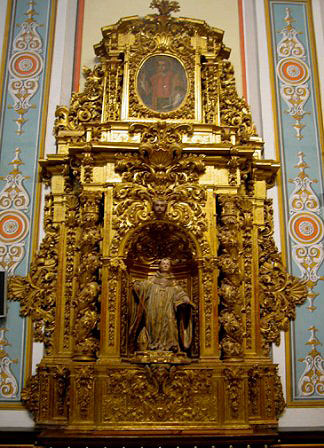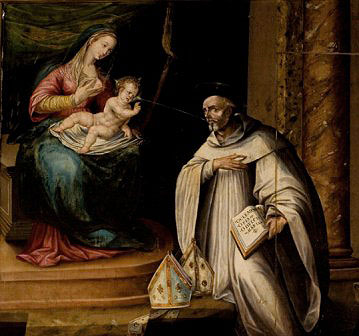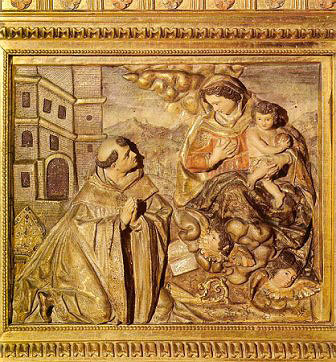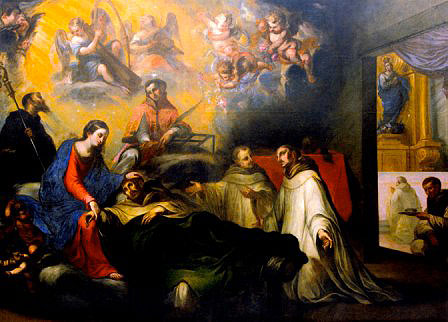18 August 2016
The monastery of Tulebras
Monstra te esse matrem: the iconography of saint Bernard
D. Ricardo Fernández Gracia
Chairof Navarrese Heritage and Art
Navarre is no exception to the reception of painted or sculpted images of Saint Bernard. His figure was present in a special and singular way in the Cistercian monasteries of Navarre and its areas of influence. It is significant that his monasteries, for which he had banned images, were populated during the Modern Age with representations of his figure and the most important scenes from his life, both real and legendary.
staffThe attractiveness of the saint, his foundations, his relationship with the Marian cult, his writings, which were of great common sense and topical at all times, and statusmeant that his representations spread to other places, promoted by prominent figures, devotees and institutions.
The iconographic subjectthat became generalised in his isolated figure is very repetitive. Dressed in the large, wide white cowl and accompanied by the abbot's crozier, the book in reference letterfor his numerous writings and the mitre or mitres at his feet in allusion to the bishoprics he renounced. The Cistercian or Benedictine monasteries have excellent carvings of him, such as the one in his collateral in the monastery of Fitero (1614), or the one in the main altarpiece of the monastery of Irache, today in Dicastillo, commissioned in 1617 by Juan III Imberto. Other sculptures of the saint can be found in Corella, Tafalla, Roncal, Sesma, Tafalla, Uztegui and Cascante.
Among the pictorial versions of the saint alone, we should highlight the panel in the attic of the main altarpiece of the monastery of La Oliva, now in San Pedro de Tafalla, commissioned by Rolan Mois and Paolo Schepers in 1571 and dated 1582, in which he appears kneeling, in a prayerful attitude with an open book in which the second verse of the Ave maris Stella is read, and a very rich crozier and an aurifigiata mitre at his feet.
In some cases, such as in the attic of the main altarpiece in Corella (1718-1722) or La Oliva, the saint is in an Assumptionist context. In the main altarpiece of the aforementioned monastery, the magnificent composition of the Assumption presides over the altarpiece and in the Corella altarpiece the large attic is organised around an Assumptionist group. In this regard, we should remember one of the saint's sermons for that feast, in which he says: "May our thirsty soul turn to this source, and may our misery have recourse to this treasure of compassion. Blessed Virgin, may your goodness henceforth make known to the world the grace that you have found with God: obtain through your prayers the forgiveness of the guilty, the health of the sick, the consolation of the afflicted, financial aidand freedom for those in danger". (St. Bernard, Hom. on the Assumption of the Blessed Virgin Mary, 1, 7-8). Without leaving Corella, we must remember that in 1703, several lightning bolts from a great storm on the saint's day caused enormous destruction. The Town Council agreed to celebrate St. Bernard's Day with a procession and mass to express their gratitude for the lack of victims. In the convent of San Benito lightning penetrated through the choir and Doña Paula del Bayo y Díaz de Fuenmayor, wife of Don Vicente de Ágreda y García, ordered her altarpiece to be made in her church, commissioning Juan de Arregui in 1726.

Altarpiece of San Bernardo.
Juan de Arregui, 1726
Convent of La Encarnación. Corella
Two great messages in a couple of scenes from his life
It is well known that in Cistercian spirituality the two great XXX of St. Bernard bore fruit. On the one hand, the maxim of knowing Jesus and Jesus crucified and, on the other, the extraordinary love for the Virgin which made him utter the famous phrase Mariae nunquam satis. The iconography could not remain oblivious to both directions.
Saint Bernard embraced by the Crucified One hanging from the cross, as in the iconographies of other saints such as Saint Francis of Assisi, gave artists a special motif for their compositions, although it is true that in most cases they followed engraved models shown to them by the abbots of the monasteries or the promoters. In Navarre, the large panel of the main altarpiece in Fitero, the work of Rolan Mois (1590-1591), stands out, as does the relief of the altarpiece of the saint in Leire - a monastery that was in the Cistercian orbit from 1269 - and a small painting from La Oliva in the parish church of Beire. All of them are testimonies to the intense and moving passage narrated in the biographies of the saint and which was also reflected in literature in one of the most popular devotional books in Spain since its first edition in 1599, the Flos Sanctorum or book of the lives of the saints, by Pedro de Ribadeneyra.
In connection with this topicand the Passion of Christ, mention should be made of some compositions disseminated through prints in which the saint appears surrounded by the attributes of the Passion, as in a panel from the monastery of Fitero, from the attic of its altarpiece, in a canvas of the Conceptionist Recollects of Estella or in the relief of the attic of the altarpiece of San Bernardo de Leire.
But the great scene linked to his life comes from a legendary account in the hagiography of Saint Bernard alluding to the passage of the lactatio, which depicts the Virgin who stops breastfeeding the Child to send a small stream of milk to the saint, making him the so-called mellifluous doctor, in allusion to the milk-like sweetness of his eloquence in his treatment of Mary. Accounts of the event differ. According to some, the abbot of Citeaux sent Saint Bernard to speak to the bishop of Chalon. The saint, before carrying out mission statement, wanted to pray before an image of the Virgin Mary, which miraculously spurted a stream of milk on the saint. According to others, while he was praying and enraptured by the Virgin, the latter sprinkled milk from her breast on the saint's lips, claiming that the prayer he was praying was the verse "Monstrate esse Matrem" from the Ave Maris Stella, in which Mary is asked to show herself to be a true mother. Some hagiographers say that the event took place in the church of Saint Vorles, in Chantillon sur Seine, when the saint was praying before an image of the Virgin breastfeeding her child. To soften the compromising statusin which the Virgin gives her milk to an adult, the Virgin is depicted at some distance from the saint, so it is necessary to paint a trickle of milk flow. In addition, the Child is in the Mother's arms even though he is not sucking, but in such a way as to authorise "the donation of milk". Saint Bernard is on a low plane, as if human, and with the praying man's hands together or with his arms apart, as a sign of gratitude and admiration.
The scene can be found in significant places, such as the staircase of the monastery of Leire, in the aforementioned high altarpieces of Fitero and Irache, in a relief of the old altarpiece of the Benedictine nuns of Estella, the work of Juan Imberto III (now in Leire), the attic of the altarpiece of the high altarpiece of Santa María de Aibar (1710), and some dynamic and colourful canvases of Tulebras, Javier Castle and the Comendadoras de Puente la Reina, both in the Baroque style.

Lactatio of Saint Bernard
Rolan Mois, 1590
High altarpiece of the monastery of Fitero

Lactatio of Saint Bernard
Altarpiece from the Benedictine nuns of Estella,
now in the monastery of Leire
Juan Imberto III, first half of the 17th century
Series: literary texts and engraved sources
The great series of paintings on the life of the saint is the one executed by Vicente Berdusán in Tudela for the monastery of Veruela (1671-1673), which was promoted by the abbot Fray Francisco Confredi (1672-1676) and is now in the Museum of Saragossa and in Veruela. The literary passages from his hagiographies are poured into the canvases of the conversion of Duke William, the miracles in Constance, the saint forcing the devil to supplant the wheel in the Alps or the miraculous healing of the saint are an excellent example of how the painter had reached the highest quality in his extensive output. The texts of Ribadeneyra, the Vita Prima, or the Liber miraculorum in Germanico itinere, are found in textual parallelism with Berdusán's images chosen in a context of marvellousness and therefore of the saint amidst prodigious and miraculous events.

Healing of Saint Bernard
Vicente Berdusán, 1671-1673, for the monastery of Veruela
Scenes from the life of the saint can be found in his altarpieces in the monasteries of Fitero and Leire. In the latter, the sculptor Juan de Berroeta (b. 1630) copied in all his reliefs the engravings illustrating the Vita et miracula divi Bernardi Clarevalensis abbatis..., published in Rome in 1587 at the request of the Cistercian Congregation of the Crown of Castile. The reliefs narrate, in addition to the lactasis in the centre, the vision of the Birth of Christ, the embrace of the Crucified One, the mass with the vision of the souls in purgatory and the healing before the Virgin, Saint Benedict and Saint Lawrence. In the case of Fitero (1614), the paintings on the bench of his altarpiece show Saint Bernard listening to a choir of musical angels, the conversion of the Duke of Aquitaine, the miracle of the wheel and the saint dictating a letter to William for his nephew Robert of Chantillon while a great storm was raging, leaving the paper completely dry. Some of these events were recorded by Ribadeneyra and were already recorded in the Vita prima of the saint written by William of Saint-Thierry.
